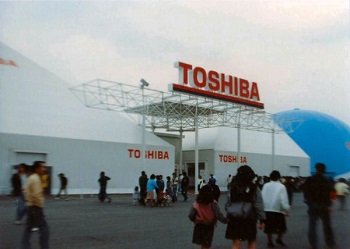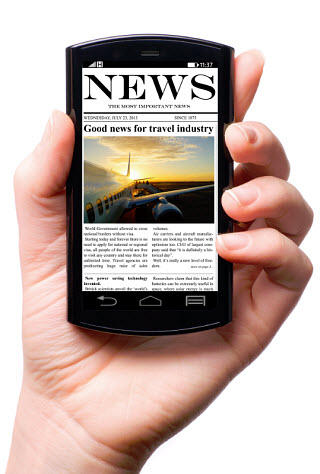The brand has decided not to use the over-the lens prism that was selected for Google Glass.
The latest brand to have their eye – so to speak – on the smart glasses market appears to be Toshiba, which has just finished revealing their prototype in Japan at the Ceatec trade show.
While these wearables may not be ready to bump Google Glass out of the running, price may be in their favor.
So far, it looks as though the smart glasses that could be offered by Toshiba would be a bit more affordable than Google Glass, which comes with a hefty price tag, at the moment. They are currently calling this wearable technology device Toshiba Glass. While they do include a built-in projector, they are unlike the current front runner in this category in that the image that they display is simply reflected off the inside of the lens in order to provide the wearer with a kind of augmented reality display experience.
This makes the idea similar to Google’s smart glasses, but at the same time, they are rather different.
 The Toshiba wearables feature a lightweight, small projector that is clipped onto one of the arms of the eyewear, close to the lens. It is that projector that reflects the image off the lens for the viewer to see in augmented reality. Google’s option also uses a projector, but its design is different in that it uses a prism over the lens in order to reflect the projected image to be seen by the wearer’s eye.
The Toshiba wearables feature a lightweight, small projector that is clipped onto one of the arms of the eyewear, close to the lens. It is that projector that reflects the image off the lens for the viewer to see in augmented reality. Google’s option also uses a projector, but its design is different in that it uses a prism over the lens in order to reflect the projected image to be seen by the wearer’s eye.
The product from Toshiba skips the use of the prism and has constructed the lens, itself, to be made up of a series of slim vertical prisms that are essentially invisible while looking directly through the lens as you would as you went about your daily routines. However, it allows an image to be projected upon them from an angle so that the wearer will be able to see it.
The specs from the company state that the device, as a whole, weighs about the same as Google Glass, at 42 grams. That said, they aren’t quite up to that level, particularly in that they are not wireless, as a battery in the projector would make the weight too high.
A new global survey has found that the vast majority of air travelers are tech-savvy.
The survey, which was conducted jointly by Societe Internationale de Telecommunications Aeronautiques (SITA) and Air Transport World, revealed that while almost all of the surveyed passengers use some form of mobile technology when travelling, 77 percent of the 6,277 passengers surveyed would be content using wearables such as smartwatches and smart glasses to make their journey more interesting or to help them during their travels.
The survey focused on consumers travelling through the 30 top airports across the globe.
The global survey carried out by the aviation communication and IT firm based in Geneva and the aviation journal, showed that nearly every passenger (97 percent) had a smartphone, tablet or laptop with them when they flew and that one in five passengers surveyed travelled with all three of these devices. This finding alone highlighted the increasing importance of passengers who are tech-savvy.
Passengers want to be able to use mobile technology at every point of their journey.
 The survey also learned that air travelers want to stay connected at each part of their journey. The study found that 76 percent of respondents utilized airline apps and that of this same group, 43 percent said that the apps made a distinct improvement when planning their travels and during their travel experience.
The survey also learned that air travelers want to stay connected at each part of their journey. The study found that 76 percent of respondents utilized airline apps and that of this same group, 43 percent said that the apps made a distinct improvement when planning their travels and during their travel experience.
In addition, 54 percent of participants wanted there to be a greater investment in technology to assist them in comparing airline fares. Furthermore, 52 percent wanted in-flight wireless service and improved real-time flight information. Also, the survey revealed that 57 percent would like airport directions and maps and 53 percent wanted personalized alerts sent directly to their phones to notify them about any delays.
The survey clearly reveals that mobile technology is important to air travelers. According to Francesco Violante, the CEO of SITA, passengers who are tech-savvy “expect more personalised apps and services consistently delivered on the web, to their phone or tablet. New technologies like smart watches and glasses have now become commonplace and “they present a great opportunity for airlines and airports to engage directly with their passengers to provide efficient services throughout the journey.”
 The Toshiba wearables feature a lightweight, small projector that is clipped onto one of the arms of the eyewear, close to the lens. It is that projector that reflects the image off the lens for the viewer to see in augmented reality. Google’s option also uses a projector, but its design is different in that it uses a prism over the lens in order to reflect the projected image to be seen by the wearer’s eye.
The Toshiba wearables feature a lightweight, small projector that is clipped onto one of the arms of the eyewear, close to the lens. It is that projector that reflects the image off the lens for the viewer to see in augmented reality. Google’s option also uses a projector, but its design is different in that it uses a prism over the lens in order to reflect the projected image to be seen by the wearer’s eye.
 The survey also learned that air travelers want to stay connected at each part of their journey. The study found that 76 percent of respondents utilized airline apps and that of this same group, 43 percent said that the apps made a distinct improvement when planning their travels and during their travel experience.
The survey also learned that air travelers want to stay connected at each part of their journey. The study found that 76 percent of respondents utilized airline apps and that of this same group, 43 percent said that the apps made a distinct improvement when planning their travels and during their travel experience.